Understanding how to swing a golf club is the first step toward becoming a proficient golfer. This guide will walk you through the key aspects of a successful swing. In addition to learning how to swing a golf club, discover tips for selecting the best golf ball and golf shoes to maximize your performance on the course.
As a professional golfer, I’ve learned that the fundamentals often make the most significant difference. This article delves into the essentials of a perfect golf swing, drawing insights from Pete Cowan, the world’s number-one golf coach.
By focusing on grip, setup, and body movement, you’ll find the fastest way to improve your golf swing. Let’s begin this journey to better ball-striking consistency.
The Foundation of a Great Golf Swing
The Grip – Your Connection to the Club
Your grip on the golf club is crucial. It determines the direction and accuracy of your shot. Imagine the grip as the steering wheel of your golf swing. If you hold it correctly, you’ll guide the ball precisely where you want it to go. Here’s how to get it right.
Start with the Left Hand
Place the club down with the bottom flat on the ground. Align the face of the club towards your target. Your left hand should grip the club with the fingers wrapped around the back, and the thumb resting on top.
Check Your Knuckles
From your viewpoint, you should see the first two knuckles of your left hand. The crease between your thumb and index finger should point towards your right shoulder.
Add the Right Hand
The right hand wraps around the back of the club, with the thumb resting on the left thumb. For a more secure grip, interlock the little finger of your right hand with the index finger of your left hand.
The Setup – Positioning Yourself for Success
Once your grip is secure, the next step is to position your body correctly. Your stance and posture will influence your balance, speed, and stability. Follow these guidelines:
- Feet Position: Start with your feet close together. Place the club behind the ball, then separate your feet to be shoulder-width apart.
- Body Alignment: Push your hips back, keep your back straight, and slightly flex your knees. Your arms should hang naturally from your shoulders, maintaining a comfortable distance from the club.
The correct setup
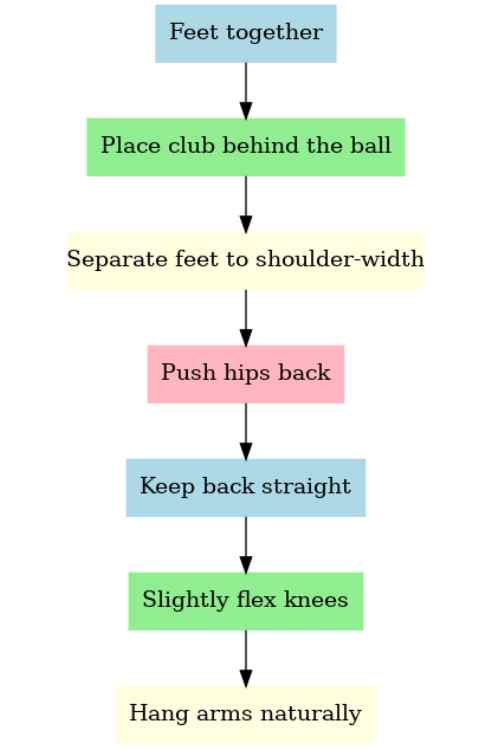
Body Movement – The Key to a Powerful Swing
The golf swing is essentially a combination of body rotation and weight transfer. Think of it as similar to throwing a ball:
Rotation: Turn your shoulders and hips away from the target on the backswing.
Weight Transfer: Shift your weight from your back foot to your front foot as you swing through the ball.
Here’s a graph to visualize the rotation and weight transfer during a swing:
Now, practice these movements without hitting the ball. Place the club across your shoulders and twist your body back and forth, focusing on the rotation and weight transfer.
Key Points for a Proper Grip
| Left Hand Position | Right Hand Position | Checkpoints |
| Fingers around the back of the grip | Fingers around the back of the grip | See two knuckles on the left hand |
| Thumb straight on top | Thumb on top of left thumb | Crease points to right shoulder |
| Comfortable and secure | Interlock fingers for new golfers | Aim for a 5/10 tightness |
| Palm facing inward | Palm facing inward | Club rests diagonally across fingers |
| Thumb slightly to the right of the grip | Pinky overlaps or interlocks with left index finger | Check for a “V” shape between thumb and index finger |
| Pressure applied by last three fingers | Pressure applied by middle two fingers | Hands work together as a unit |
| Knuckles slightly visible | Two knuckles visible on the back of the right hand | Maintain consistent grip pressure throughout the swing |
| Keep wrist flat | Avoid gripping too tight | Hands should feel connected to the club |
Setup Checklist
Setup List for a Proper Golf Swing
- Feet: Shoulder-width apart.
- Hips: Pushed back.
- Back: Straight.
- Knees: Slightly flexed.
- Arms: Hang naturally.
- Weight: Balanced on the balls of your feet.
- Chin: Slightly tucked to allow room for shoulder turn.
- Shoulders: Square and relaxed.
- Eyes: Focused on the ball.
- Hands: Positioned just ahead of the ball at address.
- Clubface: Aligned square to the target.
- Alignment: Feet, hips, and shoulders aligned parallel to the target line.
Rotation and Weight Transfer Steps
- Turn shoulders and hips on the backswing
- Shift weight from back foot to front foot
- Follow through with a balanced finish
To help visualize the weight transfer and body rotation.
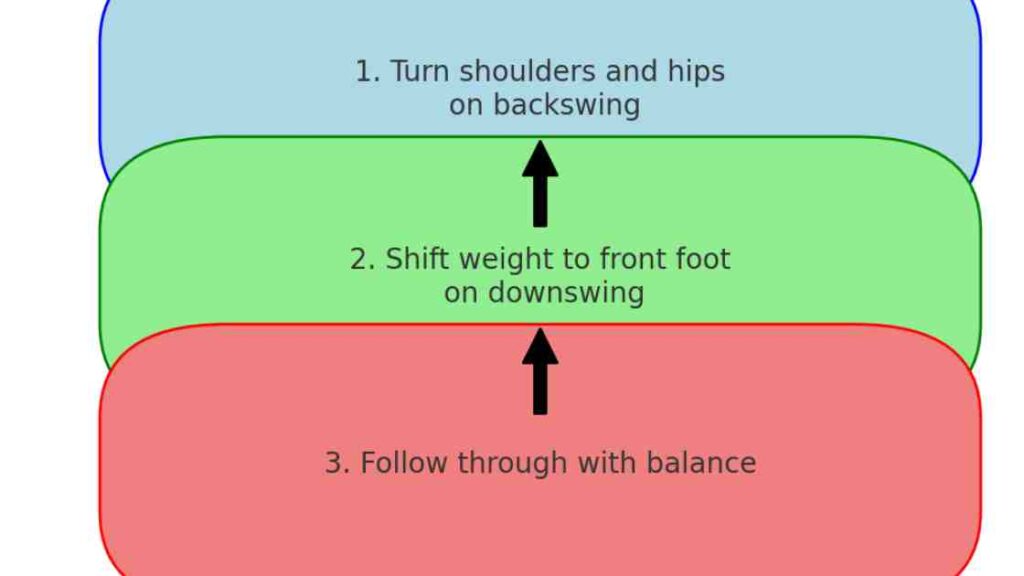
With these fundamentals in place, you’ll have a solid foundation for a powerful and accurate golf swing. Remember, practice makes perfect. Spend time refining your grip, setup, and body movement. Watch videos, observe your stance, and make adjustments as needed.
With a solid grip, proper setup, and foundational body movements in place, it’s time to dive deeper into the mechanics of a perfect golf swing. Understanding the nuances of swing mechanics, shot consistency, and strategic practice will further refine your game. In this step, we’ll explore advanced techniques and strategies that will elevate your swing to the next level.
Refining Your Swing Mechanics
Understanding the Swing Path
The path of your golf swing is critical in determining the accuracy and distance of your shots. Here’s how to perfect your swing path.
Backswing Path: Start by taking the club back low and slow. The clubhead should move straight back along the target line before gradually rising.
Top of the Swing: At the top of your backswing, your club should be parallel to the target line. Your wrists should be fully cocked, and your left shoulder should be under your chin.
Downswing Path: Initiate the downswing with your hips, not your arms. The clubhead should follow an inside path, approaching the ball from the inside for maximum power and accuracy.
The correct swing path
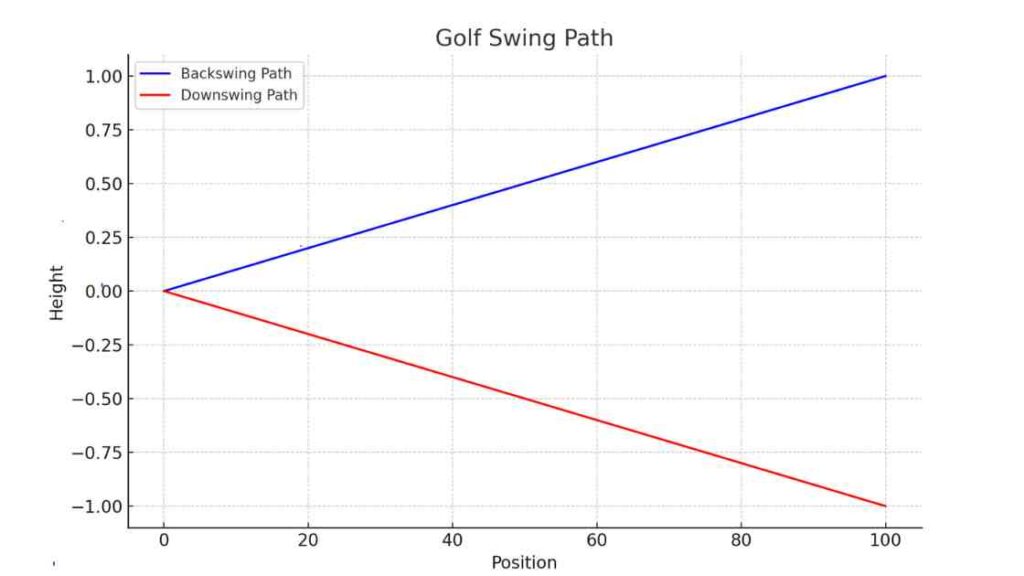
The Role of Wrists in the Swing
Proper wrist action can significantly impact your swing’s power and control. Here’s a breakdown of wrist movements during the swing:
Hinge on the Backswing: As you take the club back, hinge your wrists upward. This action helps store energy for the downswing.
Release on the Downswing: Unleash this stored energy by releasing your wrists through impact. This creates a whipping effect, adding speed and power to your swing.
Follow-Through: Maintain a relaxed grip and allow your wrists to naturally follow through the swing, ensuring a smooth finish.
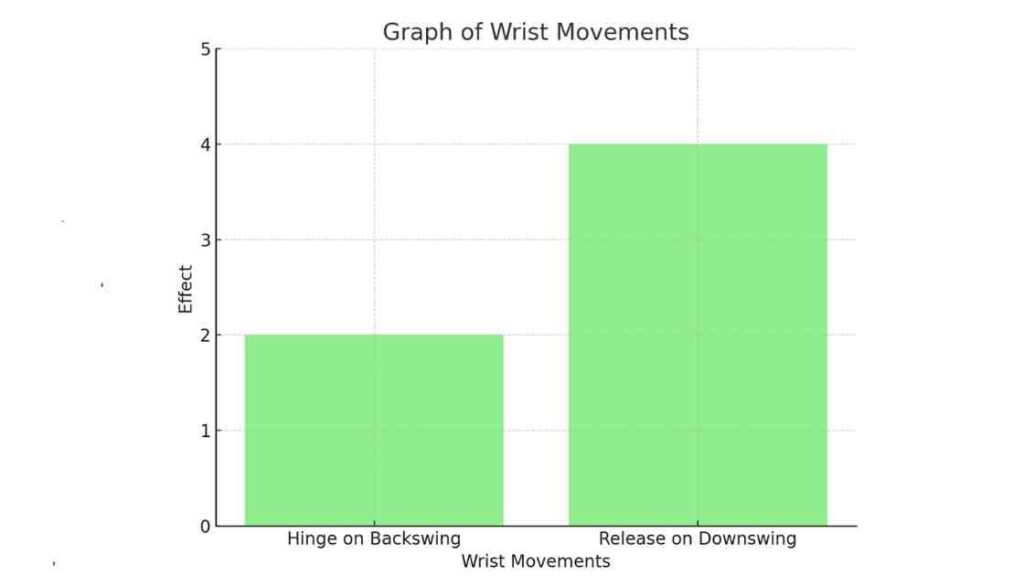
Consistency and Control
Consistency is key in golf. To achieve consistent ball striking, focus on these elements:
Rhythm and Tempo: Maintain a steady rhythm and tempo throughout your swing. A smooth, even pace will help you control the club and make consistent contact with the ball.
Balance: Ensure you stay balanced throughout the swing. Your weight should shift naturally from your back foot to your front foot without causing you to lose balance.
Impact Position: Aim for a consistent impact position where your hands are ahead of the clubhead at the point of contact. This ensures solid ball striking and better control.
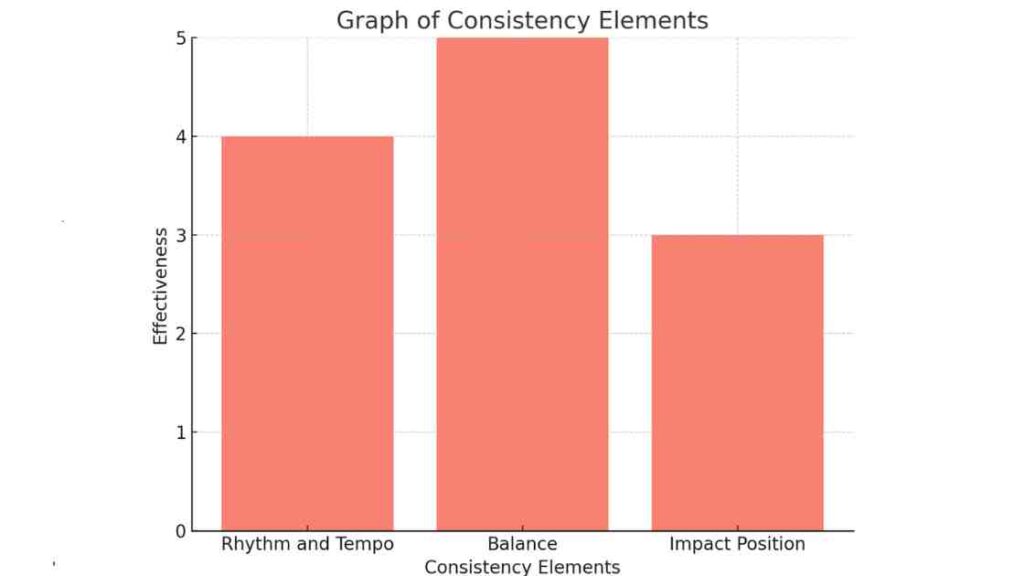
Summarizing key points
| Element | Key Points |
| Rhythm and Tempo | Maintain a smooth, even pace. |
| Balance | Natural weight shift, avoid losing balance. |
| Impact Position | Hands ahead of clubhead at contact. |
List of these drills for easy reference:
- Swing Path Drill.
- Wrist Hinge Drill.
- Impact Bag Drill.
Advanced Techniques for Better Ball Striking
The Power of Visualization
Visualization can be a powerful tool in improving your golf swing. Imagine the perfect swing in your mind before you execute it. Visualize each step, from the takeaway to the follow-through. This mental rehearsal helps reinforce muscle memory and boosts confidence.
- Pre-Shot Routine: Develop a consistent pre-shot routine that includes visualizing the shot. This routine helps calm your nerves and prepare your mind for the swing.
- Focus on the Target: Instead of fixating on the mechanics, focus on your target. Visualize the ball traveling towards the target and landing exactly where you want it.
Adapting to Different Lies and Conditions
Golf is a game of variable conditions. Being able to adapt your swing to different lies and weather conditions is essential:
Uphill and Downhill Lies
Adjust your stance and swing to accommodate the slope. For uphill lies, tilt your shoulders to match the slope and swing along the slope. For downhill lies, do the opposite.
Wind Conditions
In windy conditions, adjust your ball position and swing to control the ball flight. A lower ball flight helps in windy conditions.
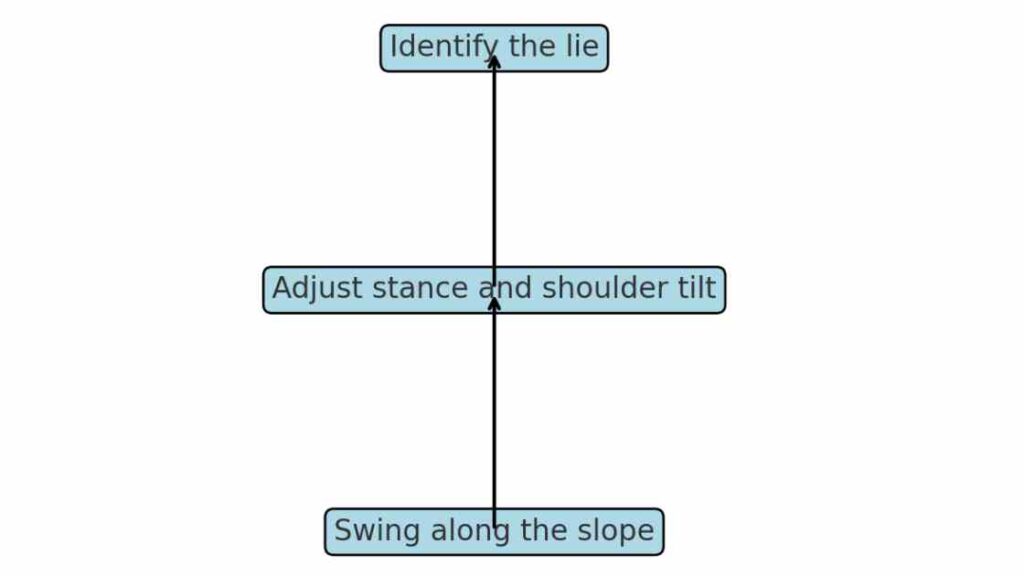
Advanced Techniques
Visualization and Focus
| Technique | Key Points |
| Pre-Shot Routine | Develop consistency; visualize the shot. |
| Focus on the Target | Visualize the ball traveling to the target, not mechanics. |
| Smooth Transition | Ensure fluid movement from backswing to downswing. |
| Tempo and Rhythm | Maintain consistent tempo and rhythm throughout. |
| Shot Selection | Assess and select the right shot for the situation. |
| Shot Shaping | Learn to curve the ball intentionally. |
Adapting to Conditions
| Condition | Adjustment |
| Uphill Lie | Tilt shoulders to match slope, swing along slope. |
| Downhill Lie | Tilt shoulders to match slope, swing along slope. |
| Windy Conditions | Lower ball flight, control ball position. |
In the final part of our journey to mastering your golf swing, we will consolidate everything we’ve learned about how to swing a golf club and focus on strategic practice routines. These routines will help you ingrain the techniques we’ve discussed, leading to lasting improvement.
Additionally, we’ll explore mental strategies and on-course management tips that will further enhance your game and reinforce how to swing a golf club effectively in various game scenarios.
Strategic Practice and Mental Mastery
Structured Practice Routines
Practicing with a purpose is crucial. Here’s a breakdown of practice routines designed to improve specific aspects of your golf swing.
Routine 1: Grip and Setup
- Warm-Up: Begin with light stretching and a few practice swings to loosen up.
- Grip Check: Spend 10 minutes ensuring your grip is correct. Use a mirror or video yourself to verify.
- Setup Drill: Practice setting up to the ball. Focus on maintaining proper posture, shoulder width, and alignment.
Routine 2: Swing Path and Impact
- Swing Path Drill: Place alignment sticks on the ground to create a channel. Swing within this channel for 15 minutes to engrain the correct path.
- Impact Bag Drill: Hit an impact bag to practice achieving the correct impact position. Spend 20 minutes on this drill.
Routine 3: Full Swing Practice
- Combining Elements: Spend 30 minutes practicing your full swing, integrating grip, setup, swing path, and impact position.
- Varied Clubs: Practice with different clubs to adapt your swing to various situations.
Summarizing these routines
| Routine | Focus Areas | Time Allotted |
| Grip and Setup | Grip check, setup drill | 30 minutes |
| Swing Path and Impact | Swing path drill, impact bag drill | 35 minutes |
| Full Swing Practice | Combining elements, varied clubs | 30 minutes |
The Importance of Feedback
Receiving feedback is essential for improvement. Here are ways to get effective feedback:
Self-Analysis: Use a mirror or video recording to analyze your swing. Compare it to professional golfers or instructional videos.
Coaching: Take lessons from a qualified golf coach. A coach can provide personalized feedback and correct any mistakes you might not notice.
Peer Feedback: Practice with a friend and provide feedback to each other. Sometimes, another set of eyes can catch details you might miss.
Technology Tools: Utilize technology like swing analysis apps or gadgets. These tools can provide detailed metrics on your swing speed, angle, and trajectory, offering objective data for improvement. They often include features for side-by-side comparisons with professional swings, helping you pinpoint areas needing adjustment.
Course Feedback: Play rounds with different golfers or participate in tournaments. Observing how others handle various course challenges can offer insights into your own strengths and weaknesses. It’s a practical way to gather feedback in real game situations, where decisions and shot selections matter.
Routine Evaluation: Establish a feedback loop in your practice routine. Regularly review your practice sessions, noting what worked well and where you struggled. This reflective practice not only reinforces good habits but also identifies recurring issues that need focused attention.
Online Communities: Engage in online golf forums or communities. Share videos of your swings and seek feedback from experienced players or instructors who frequent these platforms. It’s a virtual way to tap into a diverse pool of perspectives and expertise, often leading to constructive advice and tips.
Mindset and Adaptation: Approach feedback with a growth mindset. Embrace criticism as opportunities for growth rather than personal failures. Adaptation is key; use feedback to adjust your approach and techniques progressively. Over time, this mindset fosters continuous improvement and resilience on the course.
Mental Strategies for Success
Golf is as much a mental game as it is a physical one. Here are some strategies to strengthen your mental game:
Visualization: As discussed earlier, visualize your shots before you take them. This helps build confidence and focus.
Positive Self-Talk: Replace negative thoughts with positive affirmations. Instead of thinking about what could go wrong, focus on what you need to do right.
Routine: Develop a pre-shot routine to help calm your nerves and prepare mentally for each shot.
To outline these mental strategies
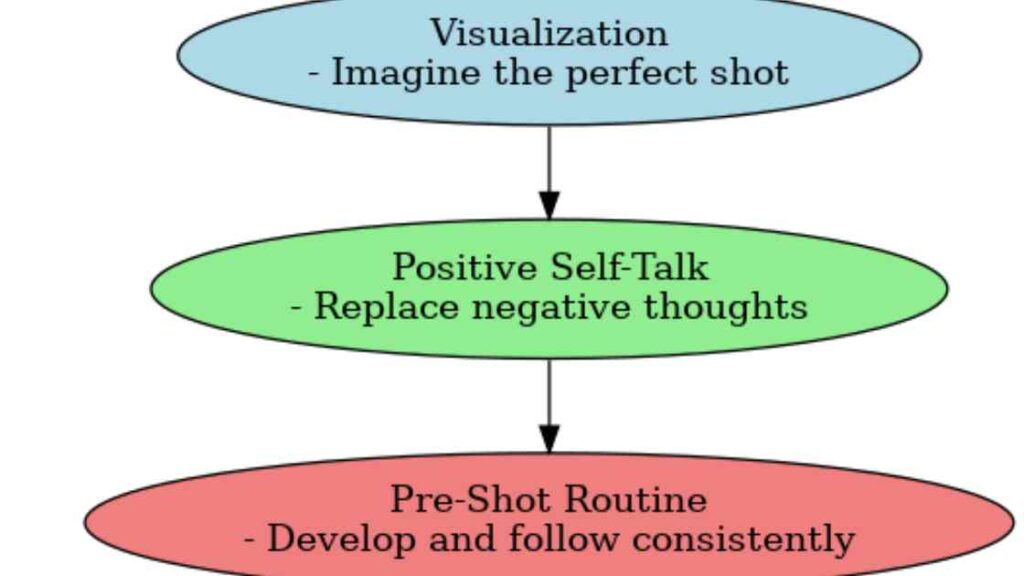
On-Course Management Tips
Strategic on-course management can lower your scores. Here are some tips:
Course Knowledge: Familiarize yourself with the course layout. Know where the hazards are and plan your shots accordingly.
Play to Your Strengths: Use clubs and shots that you’re confident with, especially in high-pressure situations.
Risk Management: Avoid unnecessary risks. Sometimes, a conservative shot is better than a risky one that could lead to trouble.
Course Management Strategies: Strategize your approach based on the hole layout. For example, on a dogleg left, aim your tee shot to the right to set up a better angle for your approach shot. Adjust your strategy based on the wind direction and speed to ensure your shots stay on target.
Patience and Decision-Making: Take your time to assess each shot. Rushing decisions can lead to mistakes. Consider the lie of the ball, your skill level, and the course conditions before choosing your next move.
Sometimes, opting for a lay-up shot to position yourself better for the next shot can be more effective than going for a risky long shot.
Course Conditions Awareness: Stay mindful of how the course conditions change throughout the round. Greens may become faster or slower, and fairways could dry out or become softer due to weather changes.
Adjust your strategy accordingly, such as adjusting your putting speed or selecting different clubs based on the conditions.
Manage Your Emotions: Golf can be mentally challenging, especially when facing a difficult course or after making a mistake. Stay focused and maintain a positive mindset.
Manage frustration by taking deep breaths and focusing on the next shot rather than dwelling on past errors. Keeping your emotions in check can lead to more consistent play.
Know Your Limits: Understand your own abilities and play within them. Avoid trying shots that are beyond your skill level, as they may result in penalties or lost strokes. Play smart and within your comfort zone to maintain confidence and improve your overall performance throughout the round.
Building a Comprehensive Practice Plan
Combining everything we’ve learned, here’s a comprehensive practice plan for a week.
Day 1: Fundamentals
- Grip Check: 10 minutes
- Setup Drill: 15 minutes
- Full Swing Practice: 30 minutes
Day 2: Swing Path and Impact
- Swing Path Drill: 15 minutes
- Impact Bag Drill: 20 minutes
- Full Swing Practice: 25 minutes
Day 3: Varied Clubs
- Practice with different clubs: 45 minutes
- Short Game Practice (chipping and putting): 30 minutes
Day 4: Feedback Day
- Video Analysis: 30 minutes
- Peer Feedback Session: 30 minutes
Day 5: Mental Practice
- Visualization Exercises: 20 minutes
- Pre-Shot Routine Practice: 20 minutes
- Positive Self-Talk Drills: 20 minutes
Day 6: On-Course Practice
- Play a round focusing on course management: 2 hours
- Practice specific scenarios (bunker shots, rough): 1 hour
Day 7: Rest and Review
- Rest day to avoid burnout
- Review notes and videos from the week: 30 minutes
This weekly practice plan for easy reference.
- Day 1: Fundamentals.
- Day 2: Swing Path and Impact.
- Day 3: Varied Clubs.
- Day 4: Feedback Day.
- Day 5: Mental Practice.
- Day 6: On-Course Practice.
- Day 7: Rest and Review.
FAQs
What are the basics of a golf swing?
The basics of a golf swing involve several key elements that contribute to a successful shot:
- Grip: Hold the club with a neutral grip, ensuring both hands work together without excessive tension.
- Stance: Position your feet shoulder-width apart, with slight flex in the knees and a straight back.
- Backswing: Rotate your torso to bring the club back smoothly, maintaining balance and keeping the club on-plane.
- Downswing: Initiate the downswing with the lower body while allowing the arms to follow naturally, generating power and control.
- Impact: Strike the ball with a square clubface, transferring energy from the club to the ball efficiently.
- Follow-through: Complete the swing with a balanced finish, ensuring the club extends toward the target and your body remains stable.
How do you grip a golf club correctly?
- Positioning: Place the club in your non-dominant hand (left hand for right-handed golfers, right hand for left-handed golfers) with the club’s grip running diagonally across your fingers from the base of your pinkie finger to the middle joint of your index finger.
- Closure: Wrap your fingers around the grip, ensuring a firm but not tight hold. Your thumb should point down the shaft with a slight gap between your thumb and index finger.
- Overlap or Interlock: For the dominant hand (right hand for right-handed golfers, left hand for left-handed golfers), place it on the grip, overlapping or interlocking the fingers with the fingers of your non-dominant hand.
- Alignment: Align the “V” shape formed between your thumb and index finger of both hands towards your trailing shoulder (right shoulder for right-handed golfers, left shoulder for left-handed golfers).
- Pressure: Apply equal pressure with both hands, ensuring a comfortable grip that allows for control and flexibility during the swing.
What is the proper stance for a golf swing?
The proper stance for a golf swing is crucial for consistency and power. Here’s a basic guide:
- Feet Position: Start with your feet shoulder-width apart.
- Alignment: Ensure your feet, hips, and shoulders are aligned parallel to the target line.
- Weight Distribution: Distribute your weight evenly between both feet, with slightly more on the balls of your feet.
- Knee Flex: Bend your knees slightly to maintain balance and mobility.
- Spine Angle: Tilt your spine forward from your hips to promote a proper swing plane.
These elements combined help establish a stable and balanced stance, essential for executing a solid golf swing. Adjustments can be made based on personal preference and the type of shot you intend to play.
How can I improve my golf swing at home?
Improving your golf swing at home can be effective with focused practice and exercises. Here are some tips.
Mirror Work: Use a mirror to check your posture, grip, and alignment. Practice your takeaway and follow-through motions to ensure they’re correct.
Swing Drills: Perform golf swing drills that emphasize key aspects like balance, tempo, and rotation. Slow-motion swings can help you ingrain proper mechanics.
Strength and Flexibility: Work on exercises to improve golf-specific strength and flexibility. Focus on core strength, shoulder rotation, and hip mobility, which are crucial for a powerful and controlled swing.
Visual Aids and Feedback: Utilize training aids such as alignment sticks, swing trainers, or even video analysis apps to get visual feedback on your swing mechanics.
Mental Visualization: Practice mental imagery of a perfect swing. Visualize yourself executing smooth, controlled swings with proper technique.
Consistent practice at home, focusing on technique and physical conditioning, can significantly enhance your golf swing and overall performance on the course.
Conclusion
Improving your golf swing is a journey that combines technical skills, mental strategies, and consistent practice. By focusing on the fundamentals—grip, setup, and body movement—and incorporating advanced techniques like proper swing path, wrist action, and mental visualization, you’ll see significant improvements in your game.
Mastering How to Swing a Golf Club is essential for improving your game and enjoying the sport more. By practicing the steps outlined in this guide on How to Swing a Golf Club, you’ll gain confidence, accuracy, and power. Keep practicing, stay patient, and soon you’ll see remarkable improvements in your swing.
Remember to practice with purpose, seek feedback, and maintain a positive mindset. Adapting to different conditions and managing your on-course strategy will further enhance your performance. Follow the comprehensive practice plan to ensure steady progress.













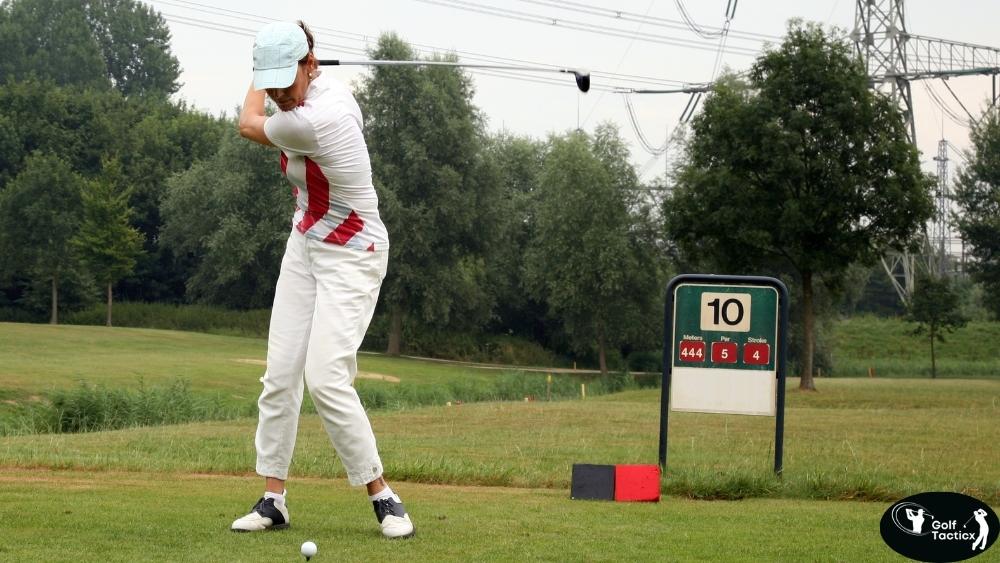


Leave a Reply